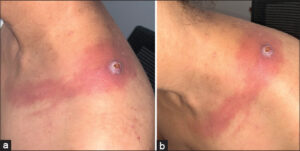Pyemotes dermatitis: Comet sign
Imane Bahbouhi , Houda Tadili, Maryem Aboudourib, Said Amal, Ouafa Hocar
, Houda Tadili, Maryem Aboudourib, Said Amal, Ouafa Hocar
Department of Dermatology and Venerology, Mohammed VI University Hospital, Av. Ibn Sina 2360, Bioscience and Health Laboratory, FMPM, Caddi Ayyad, Marrakech, Morocco
Citation tools:
Copyright information
© Our Dermatology Online 2024. No commercial re-use. See rights and permissions. Published by Our Dermatology Online.
Reactions to arthropod bites are common in summer, however their diagnosis can be occasionnally challenging. Pyemotes dermatitis is not very common and is characterized by a suggestive clinical aspect called « comet sign ». Herein, we describe a case occuring in a female patient.
In August 2021, a 45-year-old woman, consulted for a pruritic rash that appeared three days earlier. There was no evidence of return from a trip, and the patient did not recall a bite. The examination revealed a papulonodular lesion with a central haemorrhagic punctum on the left shoulder, resting on an erythematous maculopapular background associated with a linear trail extending towards the sternal region, measuring several centimeters (Fig. 1). This aspect, called “comet sign”, was suggestive of a pyemotes ventricosus dermatitis. The eruption resolved in a few days after a treatment with topical steroids.
 |
Figure 1: (a and b) Papulonodular lesion with a central haemorrhagic punctum, associated with a linear trail (comet sign). |
Pyemotes ventricosus,is a mite that parasitizes the larvae or nymphs of a large number of insects, commonly named « straw itch mite » or « grain itch mite » [1]. It usually occurs during summer, from May to September, with a peak in July and August, because the optimal temperature for its development is around 26°C [2]. The rash appears with a delay of 10 to 48 hours after the bite, and often involves covered areas [3]. The bite is usually painless [1].
Typically, the rash presents as pruritic, erythematous maculopapular lesions, sometimes centered by a vesicle, followed by the occurence of a linear erythematous streak called “comet sign” [1–3]. This sign, described by Del Giudice et al in 2006 [2], is highly suggestive of the diagnosis. This linear streak could correspond to a limited lymphangitis or could be caused by an immune response induced by the sting [1]. The treatment is symptomatic based on use of topical steroids, along with environmental measures to avoid reinfestation [3].
Consent
The examination of the patient was conducted according to the principles of the Declaration of Helsinki. An informed consent was obtained from the patient.
REFERENCES
1. Vellere I, Di Felice A, Botta A, Angheben A, Bartoloni A, Zammarchi L. Pyemotes ventricosus dermatitis:a case report and an extensive review of outbreaks and clinical cases. Infect Dis Rep. 2022;14:668–74.
2. Del Giudice P, Caumes E, Boissy C, Leduff F, Delaunay P, Blanc-Amrane V, et al. An outbreak of creeping eruption in southern France. Br J Dermatol. 2007;157:824–5.
3. Baino A, Daoumeur K, Akhdari N, Amal S. Dermatite àPyemotes. Ann Dermatol Vénéréol. 2016;143:581–2.
Notes
Request permissions
If you wish to reuse any or all of this article please use the e-mail (brzezoo77@yahoo.com) to contact with publisher.
| Related Articles | Search Authors in |
|
 http://orcid.org/0000-0002-4089-1958 http://orcid.org/0000-0002-4089-1958 |




Comments are closed.